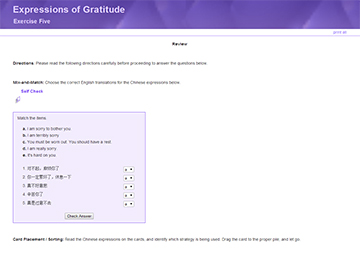Unit 5: Indirect Thanking Strategies 3
Unit 5 introduces two more types of indirect thanking strategies that are more or less specific to the Chinese language: expressing gratitude by way of apologizing and showing care.
5.1 Goal of Unit 5
The goal of Unit 5 is to familiarize students with two other indirect thanking strategies: by way of apologizing and showing care, and to provide them with a repertoire of expressions that belong to these two strategies.
5.2 Apologizing
It is a very important way to use apology to express gratitude in Chinese, which is not commonly used in American English. After receiving a favor from the hearer, the speaker thinks he/she must have brought some trouble and inconvenience, so he/she apologizes to the hearer to express gratitude. The apologizing strategy is relatively formulaic in Chinese. There are a certain number of expressions under this category that are frequently used in Chinese. For example, 对不起 duì bù qǐ /不好意思 bù hǎo yìsi/过意不去 guò yì bù qù /麻烦你了 máfan nǐ le /给你添麻烦了gěi nǐ tiān máfan le /打扰了dǎrǎo le (Bi, 1996b). Chinese speakers also modify these formulaic expressions by adding such verbs/phrases as 太 (tài) or 真(是) (zhēn shì) to intensify the degree, for example, 真不好意思 zhēn bù hǎo yì si / 太麻烦你了 tài máfan nǐ le.
It might be very difficult for American students to understand this strategy, and thus it often leads to some misunderstandings. For example, when a Chinese speaker is invited to have dinner at the house of his/her American friend, he/she expresses gratitude by saying that 对不起,给你添麻烦了 (I am sorry to have brought you much trouble). But this way of expressing thanks is constrained by politeness and cultural values in Chinese, which will be discussed in detail in Unit 7.
Thinking: Can you find out some situations in which Chinese speakers will express gratitude by the way of apologizing?
To learn more about the Chinese thanking expressions in this section, please review the Glossary below.
| Word | Pinyin | Part of speech | English translations |
| 对不起 | duì bù qǐ | N/A | I am sorry; pardon me |
| 不好意思 | bù hǎo yì si | N/A | Feel embarrassed |
| 过意不去 | guò yì bù qù | N/A | I am/feel terribly sorry |
| 麻烦你了 | má fan nǐ le | N/A | Sorry to trouble/bother you |
| 给你添麻烦了 | Gěi nǐ tiān máfan le | N/A | Sorry to have brought you trouble |
| 打扰了 | dǎ rǎo le | N/A | Sorry to trouble/bother you |
5.3 Showing Care
The other indirect thanking strategy that is more or less specific to Chinese is by way of showing care. Similar to the apologizing strategy, this indirect strategy is also constrained by politeness in Chinese which will be discussed in Unit 7.
Generally speaking, Chinese speakers tend to think from others' perspectives and show care, consideration and warmth toward other people. Therefore, showing care is one of the preferred strategies to express gratitude in Chinese. For example, if a person helps you move on a hot day, which is a big favor; according to politeness in Chinese, you may express your thanks by showing your care and empathy toward the person who has offered help. Accordingly, Chinese speakers may choose to say 你一定累坏了, 赶快休息休息 (nǐ yídìng lèi huàn le, gǎnkuài xiūxi xiūxi) or 辛苦你了 (xǐnkǔ nǐ le). Though this kind of expression sounds like a judgment to American native speakers, it is considered an appropriate way of expressing gratitude in Chinese.
Thinking: Have you heard of Chinese speakers using the way of showing care to express gratitude in everyday communication? If yes, what are the situations? How did you feel it before?
To learn more about the Chinese thanking expressions in this section, please refer to the Glossary below.
| Word | Pinyin | Part of speech | English translations |
| 一定 | yí dìng | adv | Certainly; surely |
| 累坏 | lèi huài | N/A | Worn out |
| 赶快 | gǎn kuài | adv. | Hasten; lose no time |
| 休息 | xiū xi | verb | To rest; to take a break |
| 辛苦你了 | Xīn kǔ nǐ le | N/A | It's hard on you |
Review
Please review the information in this lesson at the Review link.
